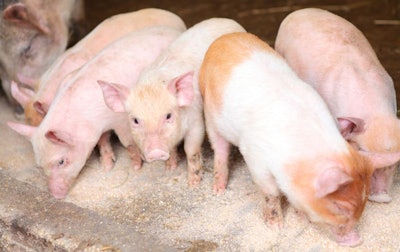
Researchers report their experiences at the Animine-European Federation of Animal Science Joint Academy in Paris.
It was in 1989 when Danish researcher Dr. H. D. Poulsen announced at the 40th annual meeting of the European Association for Animal Production in Dublin that zinc oxide at pharmacological doses could stop diarrhea in weaned pigs. Thirty years later, now in Paris during the 3rd Academy hosted jointly by Animine (France) and the European Federation of Animal Science (same organization as above but with a different name) that Danish researchers from the prestigious SEGES (Danish Pig Research Centre) research institution reported on their attempts to withdraw zinc oxide from piglet diets.
During the past three decades, Europe and Denmark in particular have become heavily dependent on medicated zinc oxide, especially since the ban on antibiotics for growth-promoting purposes. EU legislation gives until June 2022 before a complete ban on pharmacological dosages of zinc oxide is enforced.
Here are the researchers’ main findings so far.
Phasing out of zinc oxide
In 2017, Danish farms were advised to reduce levels of zinc oxide from 2,500 parts per million (ppm) down to 1,500 ppm. An estimate gives conformation to this suggestion at the level of 25%. Given the high standards of hygiene in Danish farms, especially after the ban on antibiotics in 2006, no effect was observed in animal productivity nor any increase in antibiotic use for therapeutic purposes in farms that use this lower level of zinc oxide. Such findings are really encouraging.
Replacing zinc oxide with additives
The first trial on additives indicated that replacing part or all of zinc oxide with a specific brand of a probiotic, a seaweed, and a yeast product was not successful. Given the multi-purpose role of zinc oxide inside the gut and the organism, this is not surprising, although we should not forget that response on additives is almost invariably dependent on brand and not type, although local conditions often complicate such responses even more.
Multi-factorial approach
The next trial followed the principle that we already apply in the case of antibiotics: that no single product can replace them. Researchers tried a similar approach with zinc oxide: They reduced crude protein and added four different commercial products that contained different additives. These were blends of additives based on commercial experiences offered as a package. Common to all product packages were organic acids, whereas two offers included sub-products added also in the water.
Growth was improved slightly but statistically significantly by adding 2,500 ppm zinc from zinc oxide (thankfully the trial contained a negative control). But, only one of the commercial approaches gave statistically significant growth rate similar to that of high levels of zinc oxide.
Notes on reduced crude protein
The Danish researchers decided then to investigate the impact of very low crude protein levels, while keeping critical amino acids at fixed levels. As a similar approach works reasonably well in the case of antibiotics, and because part of the response of zinc oxide overlaps or coincides with that of antibiotics, there was reasonable expectation this might work equally well.
We should not forget that zinc oxide often works on top of antibiotics as it has more roles than just controlling bacteria, but the focus of this trial was preventing diarrhea. For pigs from 6 to 9 kg body weight, they tested three protein levels: 19, 16.5, and 14%. As rightfully expected, low-protein diets reduced diarrhea but not as effectively as high levels of zinc oxide. This combines well with the results above that indicated a multi-factorial approach is not to be discarded easily.
In addition, very low diets (14% CP) also reduced productivity – again as expected, but they also reduced diarrhea, which was the primary goal. It remains now to investigate how to secure growth while preventing diarrhea with such ultra-low protein diets.
After this trial, SEGES recommends now feeding 17.5% crude protein levels in weaned piglets.
Increased feed intake post-weaning
The Danish institution also recommends taking every step possible to ensure a high level of feed intake post-weaning, especially of specialty feeds. This approach, they reason, will help piglets transition better during the post-weaning period – as shown in earlier trials. It remains to be seen if such approach holds true in diets devoid of antibiotics and zinc oxide.
 A multi-factorial approach is required to ensure weaned pigs are super healthy to require no zinc oxide in their post-weaning feeds, especially now that they are also deprived from prophylactic antibiotic usage. (Courtesy Danish Pig Research Centre)
A multi-factorial approach is required to ensure weaned pigs are super healthy to require no zinc oxide in their post-weaning feeds, especially now that they are also deprived from prophylactic antibiotic usage. (Courtesy Danish Pig Research Centre)We should not forget that when antibiotics were first banned, it was high-fiber diets (that naturally restrict feed intake) and limit-feeding methods that were advocated as a quick-response effort until a permanent solution was found. Again, the knowledge and experience gained by the ban on antibiotics might prove equally beneficial in the case of the zinc oxide ban.
It is disappointing, but understandable, to not yet have a definitive answer to this issue imposed by EU legislation. Efforts continue, and we expect that some form of solution will be found before the June 2022 deadline.
Perhaps we may have to accept lower growth performance in order to save piglets from suffering from diarrhea, at least until a future innovation comes to offer a more permanent solution. This is a new challenge for the scientific community.











